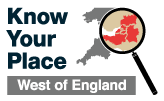What’s in it for us? SGMRG reveals how Know Your Place will help their research
by Ken Kemp, Secretary, South Gloucestershire Mines Research Group
The South Gloucestershire Mines Research Group (SGMRG) has about a hundred members who research, publicise and would like to conserve the rich industrial heritage of coal mining in the area. Many people are not aware of how important our area and Bristol were in the early development of coal mining and its contribution to the industrial revolution. Owing to adverse geological conditions, most mine sites had been abandoned by the beginning of the 20th century and were left to fall into ruins or their buildings converted to another use. There is probably a greater density of Victorian mining remains in our area, then any other part of our country.
Part of our research involves the study of old maps and plans. Many of these are to be found in the record offices at Bristol and Gloucester. The earliest Ordinance Survey large scale maps date from about 1880, but there are earlier maps such as Tithe and Apportionment maps which also show mining sites. These maps are at various scales which makes the detailed comparison of changes over time more difficult.
With the extension of Know Your Place to South Gloucestershire, SGMRG has access to high quality images of all these maps. This has a number of advantages for us. The maps are available all the time to study in our own homes. Any 2 maps can be overlaid so that common features are located on top of each other as if both maps were drawn to the same scale, making it simple to compare changes over time. It is easy to see where a mine site is located on a modern map, even if the original site has been has been completely cleared. This makes it easier to see if any traces of the original site still exist above ground.
For the record offices it has the advantage that old, fragile maps do not have to be handled to examine them by the public, and can be better conserved.
Know Your Place also has facilities for recording information submitted by the public. SGMRG can now have their findings “pinned” on the maps showing a photo and a short description. This enables our heritage to become more widely known and makes our researches available to the public.
To find out more about how your research group can get involved with the Know Your Place West of England project, go to our Supporters page.

